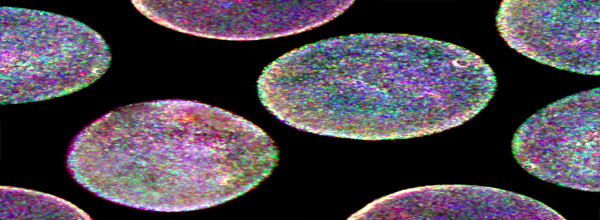I’m a simple molecular biologist. It’s awesome how computational biologists use math to reduce and rebuild biological phenomenon. In my own way, I also like to reduce my observations to numbers. As a budding biochemist, I need to assemble and quantify the players in my pathway to truly understand it. In particular, I am interested in the number of proteins per cell.
I say this because I study quorum sensing. This is the process of bacterial communication via small molecules to coordinate group behavior. The small molecules, known as autoinducers, are detected by transmembrane receptors. While trying to characterize synthetic agonists of this pathway, I became obsessed with the cellular concentrations of receptors. In unbiased screens, I kept finding agonists to a single receptor but I know there are multiple receptors that funnel information into the same pathway. Does the dominance of a single receptor arise from an increase in its relative amount? A way to answer such questions, is to use western blots to compare your endogenous protein from a known quantity of cells with a known amount of purfied protien.
Tag and Purify Target Proteins
First tag the protein of interest at the endogenous locus on the chromosome. Be sure to tag soluble proteins at the N-terminus and membrane proteins at the C-terminus to avoid messing up the signal sequence. To do this just harvest genomic DNA and use it as a template for overlap extension PCR. Then incorporate the product into a cloning vector of choice. Use the same construct to make a plasmid for purification. I prefer 3XFLAG tag for endogenous constructs and for overexpression. The westerns are cleaner and more sensitive than his-tags. If the target is a membrane protein and yield of the protein is low, test different detergents for membrane solubilization before purifying. Foscholine-12 works great for me!
Make Cell Lysates of Appropriate Growth Phase
To prepare cell lysates, pellet approximately 0.5-1 OD600 of cells carrying the tagged protein and discard the supernatant. I prepare pellets across the different growth phases from exponential to stationary. For example, I pellet 3 mL of culture at OD600 = 0.2 and 0.5 mL at OD600 = 2.0. This keeps the total within the correct range. The pellets are ready to use immediately or can be flash frozen and stored at -80oC. When ready, resuspend the pellets in 100 ul of lysis buffer (Bug Buster (Novagen, #70584–4) supplemented with 0.5% Triton-X, 50 ul/ml lysozyme, 25 U/mL benzonase, and 1 mM phenylmethylsulfonyl fluoride (PMSF)) per 1 OD600. Add SDS PAGE buffer and boil the lysates for cytoplasmic proteins or incubate lysates at 37oC for an hour for membrane proteins.
Determine Number of Cells Per OD600 for Each Sample
When pelleting cells to make lysates, be sure to plate out dilutions of the culture to determine CFUs per OD600. Initially, I first serially dilute the culture from 10 to 107 to determine the best dilution for my optical density. I found I can dilute low cell density (OD600 = 0.2) 105 . However, with high cell density cultures (OD600 = 2.0) your need to dilute to 106. For an actual experiment, I plate the dilutions in triplicate, take the average and normalize the number of CFUs to the original culture OD600. The OD600 vs CFU relationship should be linear, but there are examples of certain bacteria, especially at HCD that increase in optical density but not actual cell density.
Determine Linear Range of Detection for Western Blots
When the protein is purified and the lysates are prepared, it’s time to set up western blots! First conduct a western blot with increasing concentrations of purified protein to determine the linear range of detection. The conjugated anti-3xFLAG antibody accurate detects 2-0.06 ng of my particular protein without saturation. Similarly, determine the dilution of cell lysate that falls within this range.
Conduct Quantitative Western Blots
For the quantitative western blot, combine the increasing purified protein (within the linear range) with aliquots of cell lysate on the same gel. Typically, I used at least 4-5 different concentrations of purified protein. Calculate the linear regression from the purified protein band intensity. I only apply the linear regression to samples from the same gel. Using this equation, quantify the amount of endogenous protein from the band intensity of the samples. Then normalize to the volume loaded (not including the SDS PAGE buffer). I prefer ImageQuant TL software for this analysis. The quotient represents the concentration of protein in the cell lysate (ex: mg/ml).
Calculate Number for Proteins for OD600
Divide the lysate protein concentration by the molecular weight of the protein to convert to molarity. Don’t forget to update the molecular weight to include the tag! From here, adjust the molarity of the lysate to represent the original culture by using the ratio of 100 ul of lysis buffer per 1 OD600. Convert the molarity to moles and use Avagadro’s number to calculate the number of proteins per OD600.
Normalize Protein Concentration to CFUs
Finally, dividing the number of proteins per OD600 by the cells/OD600 of the particular sample (as determined from step 3) gives the number of proteins per cell!
If you want to see the method in action, check out this paper.1 Full disclosure…I wrote it. Nonetheless, in microbiology, many experiments involve the bulk analysis of billions of cells. Being able to count the number of proteins in a pathway helps bring into focus the abstract idea of signal transduction. This also satisfies the basic need for biologists to get quantitative.
- Hurley A, Bassler BL. (2017). Asymmetric regulation of quorum-sensing receptors drives autoinducer-specific gene expression programs in V. cholerae. PLoS Genetics, 13(5): e1006826. doi: 10.1371/journal.pgen.1006826.






